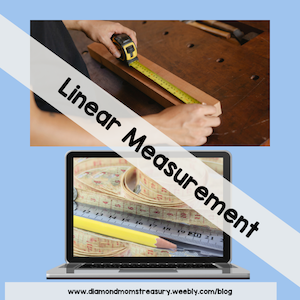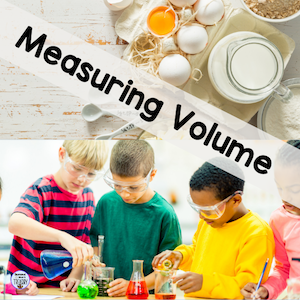|
When we think of teaching measurement, we often think of it as 2 different parts: non-standard measurement and standard measurement. Today I would like to take a look at both of these parts. Non-standard MeasurementNon-standard measurement is measuring using everyday objects as the unit of measure. It is often used for measuring lengths of things. Familiar objects are often used. Most classrooms have a variety of objects available to use. Here are some of the ones I used: blocks, links, erasers, pencils, paper clips, popsicle sticks, and straws. Although these objects can give us a number of units of length, since they are of different sizes and shapes, the answers can vary. They also are limited to measuring short distances because of the number of units required. Standard MeasurementStandard measurement uses units that are standard around the world. They may be measured using customary measuring units, imperial measuring units, or metric measuring units. Standard measurement of length is usually done with a ruler for shorter objects and a measuring tape for longer objects or distances. When measuring short distances, we use a ruler that has 12 inches or 30 cm. When measuring longer distances, we use a yardstick or a metre stick. Other instruments would be needed if measuring longer distances such as miles or kilometres. Measuring MassFor measuring mass, objects can be used for non-standard measurement. For example, marbles could be placed on one side of the scale and the object being weighed on the other side. Marbles would be added until the scale was even on both sides. Then the number of marbles used would be counted and that would be the mass of the object. Since not all marbles or other objects have a defined weight, this would be fine for a classroom activity, but the results might not be the same for each person. For measuring mass using standard measurement, weights of determined size would be used or a calibrated scale would be used. For smaller items, a kitchen scale would work. It would weigh things in ounces or pounds for customary measurement, and grams or kilograms for metric measurement. For larger items or people, a bathroom scale or a scale such as the one used at airports would be needed. This would weigh in pounds or kilograms. Measuring VolumeWhen measuring volume, non-standard measurement is not as common, but it can be used. The idea is to see how many objects would fit into something to fill it. Cotton balls, marbles, blocks, or similar items could be used. Usually we measure volume when using liquids, or ingredients for baking or doing science experiments. It is best to use standard measurement for these situations. In customary measurement, it is usually measured in cups, portions of cups, tablespoons, teaspoons, half teaspoons, quarter teaspoons. Liquid measure could also be in ounces, quarts, and gallons. In metric measurement, it is usually measured in millilitres. Liquid measure could also be in litres. Measuring TemperatureTemperature is measured in standard measurement. It is measured using the Fahrenheit (°F) scale or the Celsius (°C) scale. Depending on what is being measured, one of these scales is used. For customary measurement, the Fahrenheit (°F) scale is used. For metric measurement, the Celsius (°C) scale is used. In some cases both scales might be used. For example, I use metric for outside temperature, but customary for baking. Starting out with non-standard measurement with young children works because they don't need to learn all the terms right away, but it is important that they start to use standard measurement and become familiar with the units used once they have explored and had hands on experience to understand the concepts of length, mass, and volume. One of the ways I introduced the ruler and the term feet to my students was by having different children count footsteps along a given line to see how many feet it was. I made sure to choose children with varying foot sizes so they would get different answers. Then we discussed building a fence and going to buy the lumber. We talked about how the fence would be a different length depending on who's foot was used. Then, I introduced standard measurement. I talked about how the ruler we use is one foot long (or in metric situations, about 30cm). If everyone used the same ruler length, the fence would be one standard length. When teaching about mass and volume, baking examples or science experiment examples could be used. It is important to make connections to real situations so that they understand why they are learning about things. It is also important to give them opportunities to use the standard measurements and get practice using the terms as well. Check out this blog post for real life activities that use measurement. Here is a little measurement booklet that I made for you that might help your students with understanding the difference between non-standard and standard measurement. I have also created a measurement activity using non-standard objects. You can get your free copy here. If you would like to have some fun with using non-standard measurement in some team activities, check out this resource. If you are looking for other measurement resources, check out the measurement category in my TeachersPayTeachers store. So there you have it. These are some of the ways that I have taught measurement in my classroom and some of the activities that I have used. I would love to hear how you teach measurement in your classroom. Let me know in the comments.
Don't forget to get your free measurement booklet and activity.
2 Comments
Angela
5/2/2021 10:26:27 am
Great ideas!
Reply
Teresa Lass
5/2/2021 09:06:50 pm
Great suggestions!
Reply
Leave a Reply. |
About Me Charlene Sequeira
I am a wife, mother of 4, grandmother of 9, and a retired primary and music teacher. I love working with kids and continue to volunteer at school and teach ukulele. Categories
All
|





















 RSS Feed
RSS Feed